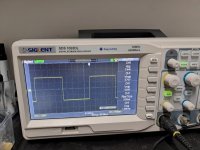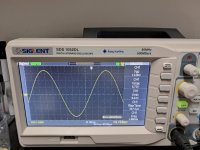Assembled 1 channel and tested this amp earlier today. Unlike my first attempt 4 years ago, this time it worked like a champ.
The only thing that could be better is slew rate. This amp seems to be on the slower side (20 V/us as far as I can tell), but totally adequate.
LT1056 was used as U2, and LF356 as U1. Later will try LT1056 as U1 (4 years ago it oscillated more with LT).


The only thing that could be better is slew rate. This amp seems to be on the slower side (20 V/us as far as I can tell), but totally adequate.
LT1056 was used as U2, and LF356 as U1. Later will try LT1056 as U1 (4 years ago it oscillated more with LT).
Attachments
Tried LT1056 as U1 (floating op-amp). Everything works the same, and amp is slightly faster (10% faster rise time on squares).
Update2: Also tried:
a) OPA134 - works exactly the same as LF356, same speed
b) LT1357 - doesn't work at all (no amplification)
c) TLE2081 - works fine, faster than LT1056 by another 10% (20% faster than LF356)
Update2: Also tried:
a) OPA134 - works exactly the same as LF356, same speed
b) LT1357 - doesn't work at all (no amplification)
c) TLE2081 - works fine, faster than LT1056 by another 10% (20% faster than LF356)
Attachments
Last edited:
It seems that the max slew rate of the amp is limited by the slew rate of U1 op-amp.
Perhaps it's worth to try slightly faster op-amps, E.g. LT1223 ?
Perhaps it's worth to try slightly faster op-amps, E.g. LT1223 ?
Last edited:
Any faster,device will improve performance,but at the cost of global stability. chose your evil....
Hi minek
nice amp.
what aoubout the output transistors. is there a change to make them faster? less cob
e.g. 2sa1987 Toshiba...but just 180W power.
kr
chris
nice amp.
what aoubout the output transistors. is there a change to make them faster? less cob
e.g. 2sa1987 Toshiba...but just 180W power.
kr
chris
Remarkable success and performance!
Minek, you are a real amp wizard. Bravo!
Minek, you are a real amp wizard. Bravo!
My previous amp (op-amp based circlophone) was built with exactly same output transistors, and achieved very high slew rate.Hi minek
nice amp.
what aoubout the output transistors. is there a change to make them faster? less cob
e.g. 2sa1987 Toshiba...but just 180W power.
So I don't think it's the output - in this case it's clearly the VAS (U1) being the bottleneck.
Nope, will try some faster op-amps soon.Is there anything which prevents you from trying other op-amps in your PCB?
Interesting thing - I replaced U2 (non-floating input op-amp) with TL071 (which is slower than LT1056), and:
a) squares rise time is faster (1.8V/us vs 3V/us)
b) there is overshot visible
So perhaps it's not U2 alone, affecting the overall speed of the amp, seems like U2 also plays a role in it.
Ignoring the overshot - I'm curious how come using SLOWER op-amp would speed the the whole amp?
a) squares rise time is faster (1.8V/us vs 3V/us)
b) there is overshot visible
So perhaps it's not U2 alone, affecting the overall speed of the amp, seems like U2 also plays a role in it.
Ignoring the overshot - I'm curious how come using SLOWER op-amp would speed the the whole amp?
I tried one more op-amp (as U1): LT1223. It's a very fast op-amp (up to 1000V/us Slew Rate), and surprisingly it 'kind of worked'.
I could see sinus or square waves on the scope, but there were some oscillations visible on the sinus/square lines.
Perhaps a matter of adjusting some RC values in the sim, or designing a better PCB with guards.
But anyway - rise time of the squares was 2us - similar like TLE2081.
So conclusion is that the overall slew rate of the whole amp is limited not just be the speed of U1, but definitely by some other factors as well.
I could see sinus or square waves on the scope, but there were some oscillations visible on the sinus/square lines.
Perhaps a matter of adjusting some RC values in the sim, or designing a better PCB with guards.
But anyway - rise time of the squares was 2us - similar like TLE2081.
So conclusion is that the overall slew rate of the whole amp is limited not just be the speed of U1, but definitely by some other factors as well.
So conclusion is that the overall slew rate of the whole amp is limited not just be the speed of U1, but definitely by some other factors as well
It might be inherent to the current dumping principle itself: the bridge comprises two reactive components which probably limit the maximal speed
Logically, the initial slope will be limited to the current available from the driver. It will slew fast up to about +/-2.6V. But you could get a better estimate by simulating a ~perfect square wave driving the drivers+outputs.
Final amp. Sound is perfect. No noise, no hum, running cool (except some resistors which are running hot).



Last edited:
- Home
- Amplifiers
- Solid State
- EZ-Dump: dump your current without really trying






